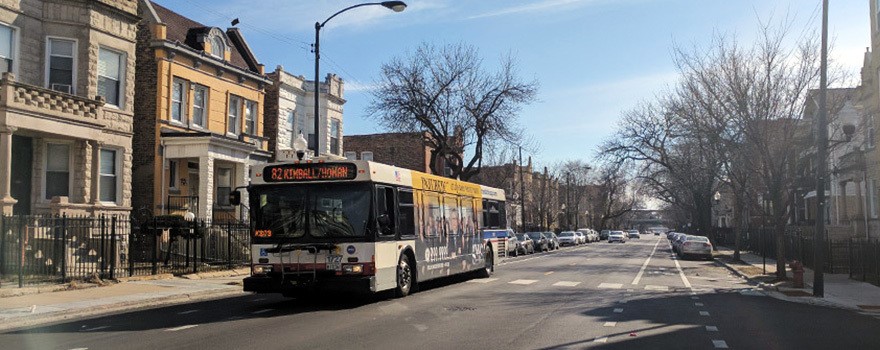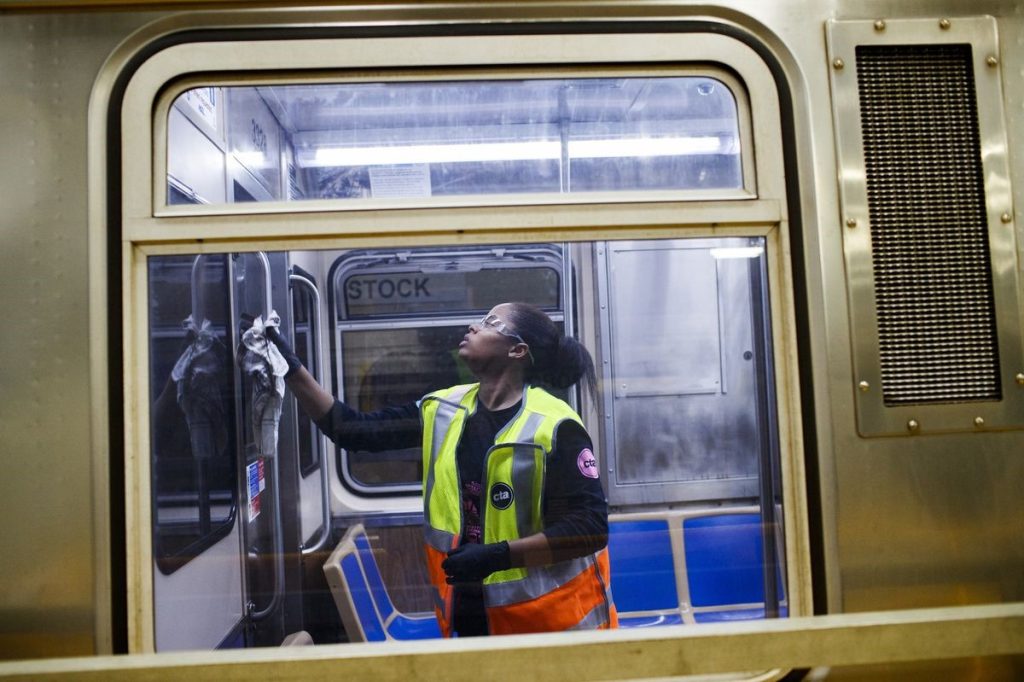The COVID-19 pandemic has changed a lot of what we perceive and know about mobility and transportation.
In recent months, Active Trans met with more than 100 stakeholders who are invested in our work. We spoke with community partners, elected officials, department of transportation and transit agency officials, and residents across the city and suburbs.
As part of this process, we held a series of small-group conversations and solo conversations with stakeholders and elected officials on the city’s North Side. Though not all-encompassing, here’s a glimpse of what residents on the North Side are experiencing.
During the course of 14 different conversations, we spoke with community members and elected officials representing Albany Park, Belmont Cragin, Edgewater, Hermosa, Lakeview, Logan Square, Lathrop Homes, Near West Side, Portage Park, Rogers Park, Six Corners, Ravenswood, and Uptown.
No matter what neighborhood people lived in or represented, a dominant sentiment that emerged was a general sense of stress and uncertainty with regards to getting around.
Several other overarching themes were:
- Essential workers continuing to rely on transit to get to work.
- An increase in walking and biking for transportation and recreation have led to congestion on sidewalks and trails.
- More infrastructure is needed for people walking and biking and more transit service is needed.
TRANSIT
At the time we conducted our interviews, communities already underserved by transit were being hardest hit by COVID-19 and people in those same communities were also more likely to be working as frontline essential workers.
In areas like Belmont Cragin where a lack of CTA train access is combined with slow and unreliable bus service, there was greater frustration about crowding on transit as COVID-19 rates were soaring.
Given the overall economic crisis and the fact that many families are struggling financially, it wasn’t a surprise that we heard praise for CTA allowing people to ride buses for free. One person shared, “With or without a pandemic, the cost is always the biggest challenge.”
Another participant offered that, “Chicago spends $4 million a day on police. It would cost a lot less to give free transit to all Chicagoans.” (Active Trans investigated the costs of providing free transit to youth and a discounted fare to low income Chicagoans in our Fair Fares Chicagoland report.)
There was praise for the transit rich areas of the North Side closer to the lake and there was some congestion reported on the Clark and Western bus routes.
Another participant lamented that, as a city, we have not taken advantage of spaces around public transit. The space can be used as an important asset for social distancing, as well as food access and housing.
Some people we spoke with reported that they had heard about people who were considering buying used cars. These considerations were prompted by concerns about virus transmission while riding transit and people’s frustrations with unpredictable transit service.
Solutions:
- Deploy more buses to crowded routes and clean buses thoroughly, posting the last time they were cleaned to reassure riders.
- Update the Bus Tracker System to reflect crowding and accurate arrival times.
- Keep transit costs low or free for riders:
- Keep buses free for the remainder of the pandemic
- Implement free fares for youth and job seekers
- Implement Fair Fares, a reduced fare program for low income Chicagoans
- Create more seating and other transit support for seniors.
- Encourage universal mask wearing by installing mask dispensers on every bus and train.
- Utilize the space around transit stops for food distribution, social distancing, and building affordable housing.

WALKING
We heard from people concerned with sidewalk crowding and crowding while waiting to cross the street at an intersection. This was particularly a problem for families and groups that walk together. We also heard about an uptick in reckless driving, which added to the stress of walking.
Some people with spoke with — especially people in Albany Park — expressed concern for small local businesses that may not have store or sidewalk capacity to social distance, but need space to safely operate their business and maintain income. Some small businesses — including businesses in Six Corners — were already struggling before the pandemic, and the pandemic may make matters worse.
We also heard concerns that sidewalk cafes have already taken over a lot of sidewalk space, especially in gentrifying communities like Logan Square, which leaves little room for wheelchair users and strollers to get by. There must be further local outreach done to determine how to meet accessibility standards while helping to support local businesses. With the huge barrier of the parking meter deal, expanding seating or sidewalk space into the street and removing parking spaces specifically is a challenge.
Solutions:
- Work with local businesses to reassess streetscapes to allow for social distancing and continued support of small businesses while maintaining access for all.
- Create shared streets with local input to allow for more space for social distancing.
- Put in place traffic calming efforts to reduce speeding and reckless driving.
BIKING
While bikes and paths that remained open were cited as assets overall, many felt there were few safe places to bike due to erratic driving behaviors and lack of safe infrastructure.
A local bike shop in Rogers Park emphasized the high demand and dwindling supply of affordable bikes, which is now a global issue highlighted by various news outlets.
A number of people we spoke with across the North Side noted an increase in biking. One participant shared, “People are walking and biking to save money while they get around, as well as for something to do.”
While the Lakefront Trail was closed, lakefront ward offices heard repeated requests to reopen the Lakefront Trail due to the density and congestion of foot traffic on sidewalks. The Lakefront Trail has since opened with a “keep moving” directive and social distance ambassadors on hand to provide guidance to users of the trail and surrounding parks.
Solutions:
- Offer free bike giveaways to those who are unemployed due to the pandemic, as suggested by one resident of Belmont Cragin.
- Build out a network of protected bike lanes, starting in neighborhoods with high crash areas that have less access to transit such as Belmont Cragin. The network of bike infrastructure must also create safe ways to get past structural barriers such as the expressways on the Northwest Side.
- Expand Divvy to the rest of the Northwest Side, and this would include introducing electric Divvy bikes to the area, as well.
- Invest in more multi-modal transportation plans that connect the alternative modes together.
INTERSECTING ISSUES
People we spoke with called for centering environmental, racial, and economic justice in the COVID-19 recovery process. What that looks like in practice is complex and varied, but it’s clear that communities with more Black and Brown residents deserve more resources, including walking and biking infrastructure and transit service on the path to recovery.
Below are some of the many intersecting issues we heard about:
- Concerns for immigrants:
- We heard about concerns in neighborhoods where many immigrants live like Albany Park, Uptown, Rogers Park, and Edgewater, that there were a lot of fears of contracting the virus and higher costs to access medical care or social services due to lack of insurance and/or citizenship status.
- Youth issues:
- We heard concerns about what transportation to and from school would look like once in-person classes would resume — and whether there would be increased congestion at school drop off and pick up points and what could be done to mitigate the increase.
- People asked about opportunities to engage youth in productive ways, have fun, and build skills while stuck at home and not being able to participate in enriching activities.
- Climate change:
- People were concerned about rising lake levels affecting the Lakefront Trail and neighborhood streets, as well as storm water runoff affecting accessibility of streets, sidewalks, and bike lanes.
- “Our economy is stuck in the past, in terms of our reliance on fossil fuels and vehicles that run on them,” said one participant. “We need a new green sustainable economy and how do we bring our built environment along? Train Black and Brown environmental engineers — we have the human capital and we need to activate it and focus it for a green new world. [These engineers could] address sustainability, transportation, education, and engineering all in one program along with an affordable home ownership program giving people who have been historically disenfranchised the opportunity to build wealth and a new green economy at the same time.”
- Affordable housing:
- We heard concerns for what happens to the most vulnerable people once the eviction moratorium ends and how that could spur rapid gentrification.
- Racial equity and funding:
- “We are not a broke city, we are the 8th richest city in the country. We have the resources but do we have the political will to prioritize the needs of most vulnerable? So far no.”
- “We need a Racial Equity Impact Assessment on the Chicago city budget. We need to ask who is our budget for and who is it benefiting and who is still suffering?”
- “The question about equity in Chicago isn’t about who has the best idea, it’s about who has the power.”
- “Our city and state taxes are regressive, meaning low income folks are paying more percentage-wise than wealthier people. Then, when you look at where resources are distributed we need, that needs to change, and when that changes that will be so transformative [with] more sustainable development, and more public transportation.”
_______________________________________________________________
Thank you to those who took the time to speak with us about transportation, mobility needs, and creating a vision for a more resilient future. We look forward to advocating for and implementing that vision together:
- State Rep. Will Guzzardi, 39th District
- State Rep. Kelly Cassidy, 14th District
- Ald. Michele Smith, 43rd Ward
- Ald. James Cappleman, 46th Ward
- Ald. Matt Martin, 47th Ward
- Ald. Andre Vasquez, 40th Ward
- Staff of 36th Ward Ald. Gilbert Villegas
- Staff of 33rd Ward Ald. Rossana Rodriguez-Sanchez
- Mark Saulys, Myron Byrd: Chicago Coalition for Homeless
- Marco De La Rosa, Janie Pittman: Boys and Girls Club Lathrop Homes
- Eric Jenkins, Near West Side Community Development Corporation
- Jeremy Cuebas and the Belmont Cragin Youth Leadership Council: Northwest Side Housing Center
- Jessica Vazquez, Six Corners Association
- Carson Poole, North River Commission
- Joe Sislow, MBAC Northwest side representative
- Christian Diaz, Logan Square Neighborhood Association
- Nelibeth Torres, Family Focus Hermosa
- Mark Frens, Bikes N Roses
- Kevin Bodkin, Laura Aranda, Tzippy Rhodes: The Recyclery
- Alma Jeronimo: Latino Union of Chicago
Be sure to read the companion blog posts featuring Chicago’s West Side, Southwest Side, and South Side.
Not member of Active Trans? Please join us. People like you allow us to do the important of improving the sustainable transportation options in Chicagoland.
Top photo courtesy of Armando Sanchez/Chicago Tribune. Lower photo courtesy of CTA.

